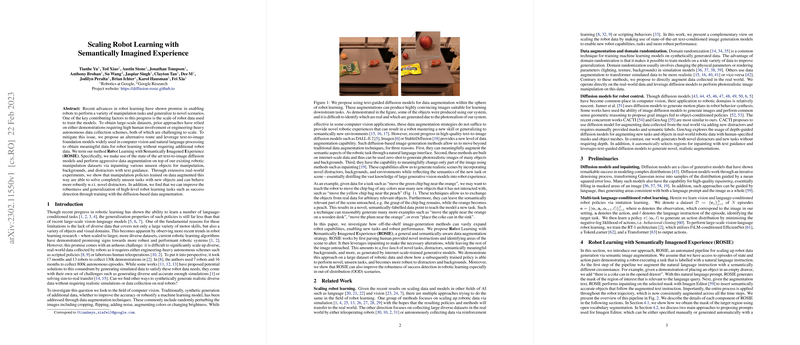Overview of "Scaling Robot Learning with Semantically Imagined Experience"
In the paper "Scaling Robot Learning with Semantically Imagined Experience," the authors present ROSIE, a novel approach for augmenting robotic learning datasets by leveraging text-to-image diffusion models. These models are used to synthetically generate diverse training data that improves the generalization and robustness of robotic manipulation policies. The methodology addresses the challenge of scaling robotic learning datasets without incurring the substantial costs associated with traditional data collection methods, such as human demonstrations or engineering-heavy autonomous schemes.
ROSIE stands out by utilizing state-of-the-art text-to-image diffusion models to semantically augment existing datasets, thereby reducing the reliance on additional robot data collection. Unlike traditional data augmentation methods that often pertain to simple pixel-based transformations, ROSIE can introduce semantically relevant objects and contextual features into robotic training environments. This approach provides a 'free lunch' of sorts, allowing robot policies to expand their understanding and capabilities in unseen environments, all while using the rich priors embedded in large generative models.
Methodology
The ROSIE framework comprises multiple steps, beginning with the detection of relevant image regions for augmentation via open-vocabulary instance segmentation using models fine-tuned on Open-Images-V5. Once the target regions are identified, prompt engineering either manually or via LLMs generates textual instructions that guide the textual diffusion models, specifically Imagen Editor, to perform inpainting on selected image segments.
This process enables the generation of novel training tasks by altering object appearances or inserting new objects into scenes. For example, given a robotic task involving a "green chip bag," ROSIE can create variations where the robot interacts with differently colored or styled items. This capability is crucial for training policies that are robust across semantically novel scenes and objects.
Experimental Results
The empirical evaluations demonstrate ROSIE's effectiveness across several fronts:
- New Skill Acquisition: ROSIE allows robots to learn new tasks that are completely unseen in the original dataset but are introduced through semantically guided image generation. The model's ability to successfully conduct tasks such as moving objects near novel containers or placing items into novel constructs like a sink highlights ROSIE's potential for expanding robotic capabilities.
- Increased Robustness: Augmenting the training set with novel backgrounds and distractors significantly improves the resilience of robot policies. This enhancement is evident in scenarios where the model's proficiency to manage distractors—like cluttered environments—shows marked improvement.
- High-Level Task Learning: Beyond low-level manipulations, ROSIE-augmented data supports high-level task learning such as success detection. By synthetically enhancing task diversity, ROSIE enables models to generalize better, even in cluttered, out-of-distribution cases.
Implications and Future Developments
The paper highlights the transformative potential of leveraging large generative models to address data scarcity in robotic learning. By employing diffusion models trained on comprehensive datasets, ROSIE demonstrates an efficient pathway to augment robot learning with semantic-rich experiences. This approach underlines a strategic direction for synthesizing training data, potentially reducing the cost and time associated with real-world data collection.
Implications for future AI development are substantial. With advancements in diffusion models and their integration into robotic systems, it is plausible to anticipate even more sophisticated generalizations and adaptability of AI models in dynamic real-world environments. Looking forward, enhancements in text-to-image technology, such as text-to-video models, could address current limitations like temporal consistency and further enrich robotic data augmentation.
In conclusion, this paper presents a meaningful stride toward scalable, semantically rich data augmentation in robotic learning. ROSIE exemplifies how AI can leverage existing computational models to not only extrapolate but thoughtfully interpolate the learning landscape of autonomous systems, paving the way for more robust, intelligent, and versatile robotic policies.
